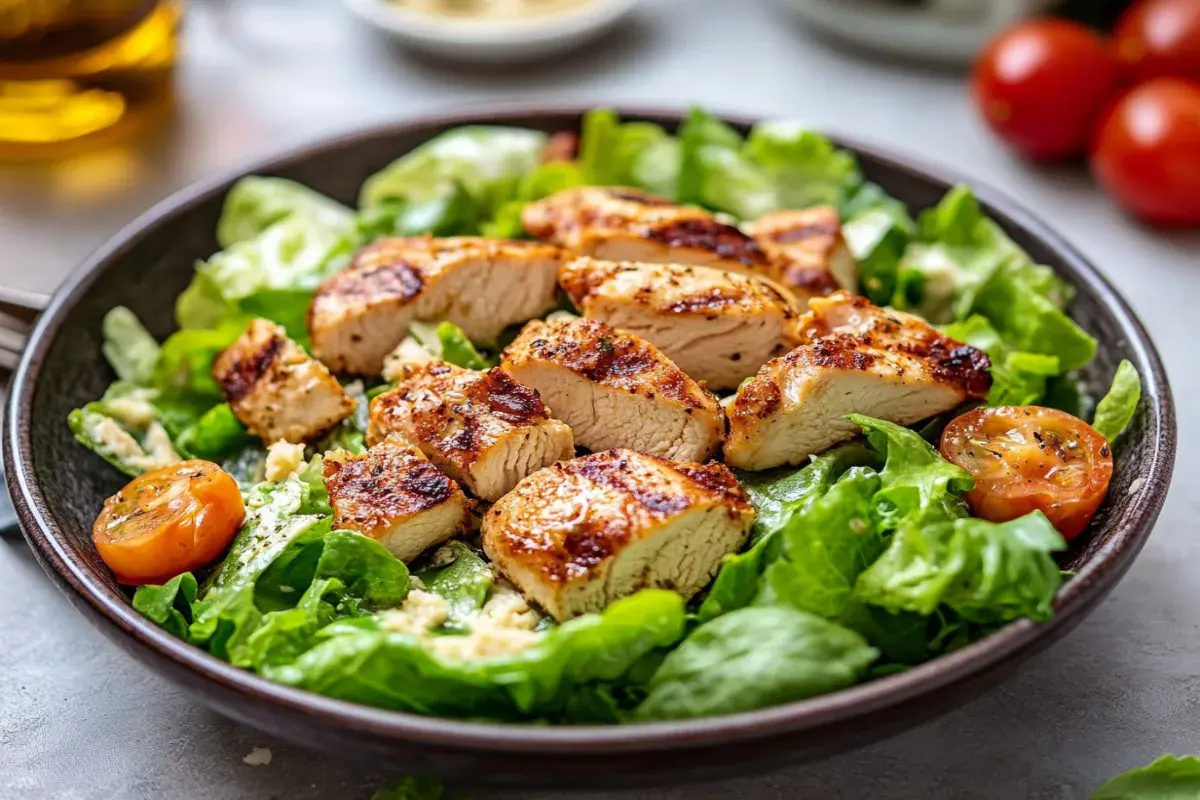Chicken Caesar salad is a well-known dish enjoyed by many for its rich, savory flavors and its combination of fresh romaine lettuce, crunchy croutons, and tangy Caesar dressing. Although it’s often thought of as a lighter meal option, there’s some debate over whether a chicken Caesar salad is truly healthy. This article will break down the nutritional content, potential health benefits, downsides, and modifications to help you enjoy this salad while maintaining a balanced diet.
What Is a Chicken Caesar Salad?
A classic Caesar salad consists of:
- Romaine lettuce
- Croutons
- Parmesan cheese
- Caesar dressing made with ingredients such as anchovies, egg yolks, lemon juice, olive oil, garlic, and mustard
The addition of grilled chicken turns it into a more filling and protein-rich meal. While the base ingredients sound healthy, the dressing can add significant calories, fat, and sodium. Over time, this dish has evolved, and many modern variations include healthier substitutions like kale, avocado, or even leaner proteins like tofu.
Chicken Caesar salads are often ordered at restaurants or prepared at home, but are they a healthy option? If you’re curious about making salads a more regular part of your diet, you can learn about the benefits of consuming vegetables with salads like these, though it’s essential to be mindful of the dressing and toppings you choose.
According to nutrition experts, while salads are a great way to incorporate vegetables into your meals, the type of dressing and extras like cheese and croutons can heavily impact the salad’s nutritional profile. Swapping out ingredients can help, and you can also explore healthier dressing alternatives to improve the overall health benefits of your salad.
Nutritional Overview of Chicken Caesar Salad
When evaluating whether a chicken Caesar salad is healthy, it’s essential to look at its nutritional breakdown. A typical restaurant-sized portion of Caesar salad with grilled chicken contains the following:
- Calories: 400-600 (depending on the size and dressing used)
- Protein: 30-40 grams
- Fat: 35-50 grams (due to the dressing and cheese)
- Sodium: 800-1200 mg (high due to the dressing and croutons)
- Carbohydrates: 20-25 grams
The salad provides a high protein content from the chicken and a good dose of vitamins A and K from the romaine lettuce. However, it also includes a significant amount of saturated fat and sodium, primarily from the Caesar dressing and Parmesan cheese. Many of these ingredients contribute to the calorie density of the meal.
Health Benefits of Chicken Caesar Salad

Despite some potential drawbacks, there are several notable health benefits to eating a chicken Caesar salad:
1. High Protein Content
Adding grilled chicken to the salad significantly increases the protein content. Protein is vital for muscle maintenance, tissue repair, and overall health. It helps you feel fuller for longer, which can assist with weight management.
2. Vitamins and Minerals from Romaine Lettuce
Romaine lettuce is an excellent source of vitamin A, which supports eye health, and vitamin K, which is essential for blood clotting. It’s also low in calories and contains water, helping you stay hydrated.
3. Customizable for Nutrient Density
One of the best things about a chicken Caesar salad is that it can be customized. Adding extra vegetables like tomatoes, cucumbers, avocado, or kale boosts the fiber and vitamin content, making it a more nutrient-dense meal.
Potential Downsides of Chicken Caesar Salad
Although a chicken Caesar salad has its merits, it’s important to be aware of the potential downsides:
1. High in Fat and Sodium
The Caesar dressing is typically made with ingredients like egg yolks, olive oil, and anchovies, which can make the salad high in saturated fat and sodium. Consuming too much sodium can increase your risk of high blood pressure, heart disease, and stroke. For those watching their sodium intake, this can be a significant concern. Even “light” versions of the dressing may still contain high sodium levels.
2. Calorie-Dense
While the salad may seem like a lighter meal, the calories can quickly add up, especially if the dressing is used generously. Restaurants often serve Caesar salads with large portions of croutons and cheese, which increase the calorie count and make it less suitable for those on a low-calorie diet.
3. Potential Lack of Variety in Vegetables
A traditional Caesar salad is limited in its variety of vegetables, relying primarily on romaine lettuce. While romaine is healthy, consuming a broader range of vegetables would provide more vitamins, minerals, and antioxidants. If you frequently eat Caesar salad, it’s beneficial to add a variety of vegetables to improve your overall nutrient intake.
How to Make a Chicken Caesar Salad Healthier
If you enjoy eating chicken Caesar salad but are concerned about its nutritional content, here are a few tips to make it healthier:
1. Opt for a Lighter Dressing
One of the most effective ways to reduce calories and fat is by choosing a lighter or Greek yogurt-based Caesar dressing. Many commercial versions are available that cut down on fat and calories while still maintaining the tangy flavor of the original. Making your own dressing at home gives you more control over the ingredients, allowing you to avoid unhealthy fats and high sodium levels.
2. Increase Vegetable Variety
A traditional chicken Caesar salad typically includes romaine lettuce as the primary vegetable, which is a great source of vitamin A, vitamin K, and fiber. However, relying solely on romaine limits the salad’s nutrient diversity. By adding a variety of other vegetables, you can boost the fiber, vitamins, minerals, and antioxidants in your salad, making it even more nutritious and satisfying.
Here are some excellent vegetables to include:
- Kale: A nutrient powerhouse, kale is rich in vitamin C, vitamin K, and calcium. It adds more texture and a slightly bitter flavor, balancing the creamy dressing.
- Spinach: Another leafy green, spinach is loaded with iron, folate, and magnesium, making it a great addition to any salad. Its tender leaves complement the crunch of croutons and chicken.
- Cucumbers: With their high water content, cucumbers add a refreshing crunch and extra hydration to your salad without adding many calories.
- Bell Peppers: Bell peppers are packed with vitamin C and antioxidants like beta-carotene, which promote immune health. Their sweet, crisp texture pairs well with the tangy Caesar dressing.
- Avocados: Though not a traditional Caesar salad ingredient, avocados provide healthy monounsaturated fats, fiber, and a creamy texture that can enhance the flavor and nutrient density of the salad.
- Cherry Tomatoes: Bursting with vitamin C and lycopene, cherry tomatoes add a juicy, sweet contrast to the savory dressing and chicken.
- Carrots: Thinly sliced or shredded carrots provide a satisfying crunch and a rich source of beta-carotene, which your body converts into vitamin A.
By incorporating these vegetables into your chicken Caesar salad, you’re not only increasing its flavor complexity but also its nutritional value. Vegetables like kale, avocado, and bell peppers offer a wide array of vitamins, minerals, and antioxidants that can support everything from heart health to immune function. Plus, the added fiber helps with digestion and keeps you feeling full longer.
3. Choose Whole-Grain Croutons or Healthier Alternatives
Croutons are a classic component of a Caesar salad, providing a satisfying crunch. However, traditional croutons made from refined white bread can add empty calories and little nutritional value. To make your chicken Caesar salad healthier, it’s a good idea to either opt for whole-grain croutons or choose alternative crunchy toppings that offer additional nutrients.
Here are some healthier crouton alternatives:
- Whole-Grain Croutons: Made from whole-grain bread, these croutons offer more fiber and nutrients than their white bread counterparts. The additional fiber helps with digestion and contributes to heart health.
- Roasted Chickpeas: A fantastic high-protein alternative, roasted chickpeas provide crunch while adding a boost of fiber and plant-based protein. They’re also lower in fat than traditional croutons.
- Nuts and Seeds: Toppings like almonds, walnuts, pumpkin seeds, or sunflower seeds not only add texture but also supply healthy fats, vitamin E, and omega-3 fatty acids. These nutrient-dense options can help support heart health and provide sustained energy.
- Baked Pita Chips or Whole-Grain Crackers: If you enjoy the crunch of croutons, consider swapping them out for lightly seasoned, baked pita chips or whole-grain crackers. These options are lower in fat and provide more fiber, making them a healthier choice.
By choosing one of these alternatives, you can still enjoy the crunchy texture in your salad while enhancing its nutritional value with extra fiber, protein, and healthy fats. This small change makes a big difference in keeping your Caesar salad satisfying and heart-healthy.
4. Add Lean Protein
In addition to the classic grilled chicken found in Caesar salads, there are other lean protein options that can provide variety and additional nutritional benefits. By incorporating different proteins, you can tailor your salad to meet specific dietary needs and preferences while boosting its overall health benefits.
Here are some excellent lean protein options:
- Grilled Salmon: Rich in omega-3 fatty acids, salmon supports heart health and provides a flavorful alternative to chicken. Its healthy fats also help keep you fuller for longer.
- Shrimp: A low-calorie, high-protein seafood option, shrimp adds a unique texture and taste to your salad. It’s also a good source of selenium, which supports immune function.
- Tofu or Tempeh: For those following a plant-based diet, tofu or tempeh are excellent choices. Both are high in protein and offer a versatile texture that pairs well with a Caesar salad. Tempeh in particular provides more fiber and nutrients due to its fermented nature.
- Hard-Boiled Eggs: Eggs are a complete source of protein and rich in essential nutrients like choline and vitamin D. Adding a couple of hard-boiled eggs is a simple way to enhance the protein content of your salad without adding excessive fat or calories.
FAQs About Chicken Caesar Salad

1. Is Chicken Caesar Salad Good for Weight Loss?
A chicken Caesar salad can be part of a weight-loss diet if you control portion sizes and make smart ingredient choices. Opt for a lighter dressing, reduce the number of croutons, and avoid extra cheese to keep the calories in check.
2. What is the Healthiest Version of Chicken Caesar Salad?
The healthiest version of a chicken Caesar salad includes:
- A lighter, Greek yogurt-based dressing
- Extra veggies like tomatoes, cucumbers, and avocado
- Whole-grain or healthier croutons like roasted chickpeas
- Moderate amounts of Parmesan cheese
This version keeps the salad light, nutrient-dense, and lower in fat and sodium.
3. Can Caesar Salad Be Made Dairy-Free?
Yes, a dairy-free version of Caesar salad can be made by:
- Using nutritional yeast as a substitute for Parmesan cheese
- Choosing a dairy-free Caesar dressing made with plant-based oils like avocado oil
These substitutions maintain the flavor and creaminess of a traditional Caesar salad without the dairy.
4. How Can I Reduce the Fat in Chicken Caesar Salad?
To reduce the fat in your chicken Caesar salad, you can:
- Use a lighter or homemade Greek yogurt-based dressing
- Limit the amount of Parmesan cheese and opt for a smaller serving
- Add more vegetables, such as kale or spinach, to bulk up the salad without adding extra fat
- Choose lean protein options like grilled chicken breast or shrimp
5. Is Caesar Dressing Bad for You?
Caesar dressing can be unhealthy if consumed in large amounts because it’s often high in saturated fat and sodium. However, using it in moderation or opting for a lighter version can still allow you to enjoy the flavors without compromising your health goals.

Conclusion
A chicken Caesar salad can be a delicious and nutritious option if you’re mindful of the ingredients. While the salad offers high protein and essential vitamins like vitamin A and K, it can also be high in fat, sodium, and calories depending on how it’s prepared. By making smart substitutions—such as using a lighter dressing, adding more vegetables, and choosing whole-grain croutons—you can enjoy a healthier version of this classic salad.
Incorporating chicken Caesar salad into a balanced diet is entirely possible when consumed in moderation and with thoughtful adjustments. Whether you’re looking for a satisfying meal or a light lunch option, this salad can be tailored to fit your nutritional needs.

